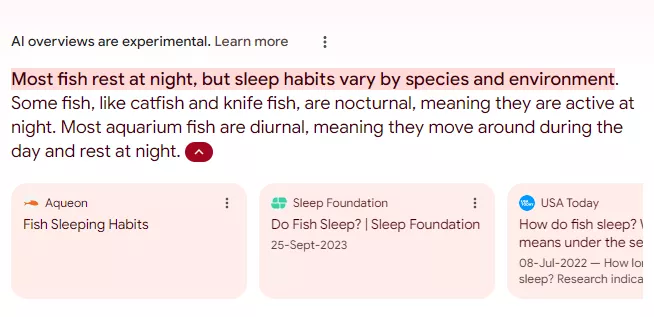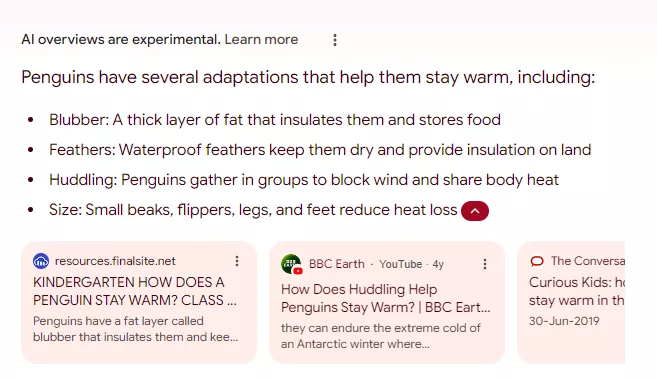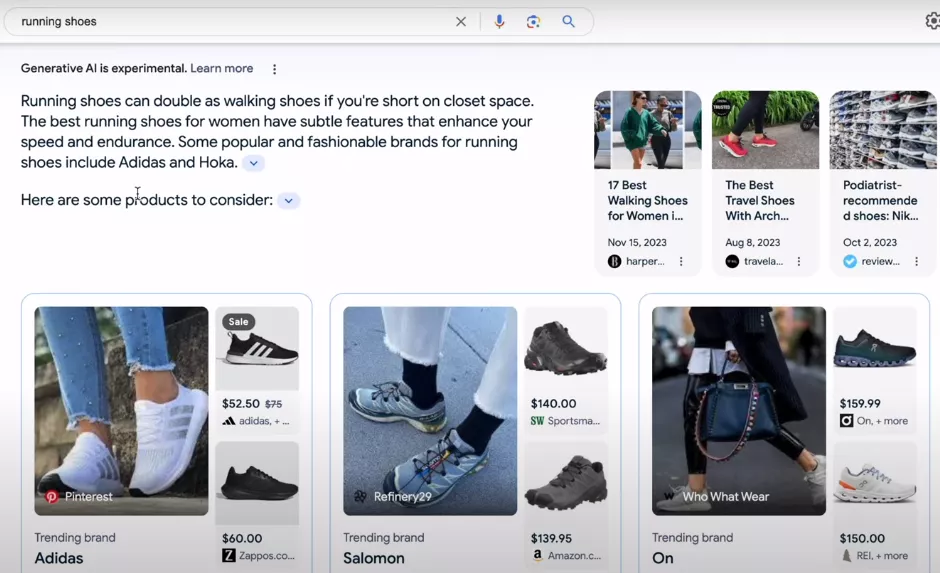What is SGE?
Google's Search Generative Experience (SGE), started in May 2023, is a search feature of Google that generates personalized search results based on user behaviour, demographics, interests and browsing history.
It makes use of generative AI and machine learning to provide visitors with to-the-point summaries of what they are looking for, right at the top of SERP, instead of exploring and going to individual pages one by one.
It is particularly useful when you are looking for a short piece of information.
Let's suppose, you want to know in which year the light bulb was invented. You won't be interested in reading long articles or texts of information. You want to get information that is readily available and to the point. Here comes the SGE that will provide you with exactly what you want.
Keep in mind that SGE is not accessible within default Google settings. To turn it on, you need to go to Google Search Labs.
Below is a screenshot of what it looks like on SERP.

How does the SGE work?
Let's say you want to learn about a topic. You ask Google by typing in a question. The normal search gives you lots of websites. Some websites may not have what you really want to know.
When you use SGE and ask a question, it makes a special page or section just for your question. This page has a simple summary which is written like a conversation.
SGE also lets you keep asking more questions about the same topic. It only shows you information that is directly about what you ask. It doesn't show you unrelated stuff.
This new AI-based search is very helpful. It stops you from going to websites that aren't useful. It also gives you the exact information you need.
See how it works:
Go to Google and start a new search.
Type your question or what you want to search for into the box.
Watch as Google writes from multiple search results as one conversational answer to your question.
It will also provide you with links for further reading.
SGE has changed a lot since its initial launch. At first, SGE just rephrased search results in a different way. But now it gives much better summaries and includes links to sources.
It uses AI to have an interactive conversation to answer your search queries. It's like a chatbot, but SGE doesn't just make up its own answers. It uses the actual search results from Google to teach itself and respond.
Types of SGE Results
Here are some of the most common types of SGE results that you may want to optimize in the future:
Carousel links
This type of SGE result shows you the top three results on the right side of the page. Optimizing your website for these top three positions can get you a huge benefit as most of the users do not go beyond 3-4 results.
Article links
This one is the most common type. It displays 2-3 links to an article relevant to your search. If you want to get more information, you can explore those links further.

Visuals
Besides text-based results, SGE also shows you images or infographics that are relevant to your search query.
Product recommendations
When you type the name of a product, SGE will show you recommendations for featured products. This is just like a featured snippet. This is how it looks for a query “running shoes”.

How to Rank in Google’s SGE?
Now that you understand what SGE is, let’s learn how to optimize your website for it.
Search engine optimization
Websites with good SEO are more likely to show up in Google's SGE. Google says SGE uses their core search ranking and quality systems like BERT, MUM, RankBrain, etc.
These core systems check things like:
If the content produced by a website is new or old
If the information is authentic
If the content is unique and matches the search intent
If the content genuinely has helpful information
If the content has links (both internal and external)
For SGE, focus on optimizing your content by:
Updating old but still useful content
Creating new, original and well-researched content
Making content easy to read and understand
Adding quotes from industry experts
Besides all these things, keep in mind that technical SEO is another important aspect of your website SEO, so don't ignore it. We will discuss it later in this article.
Google's Knowledge Graph
Google's SGE also shows up citations. The Knowledge Graph is a popular place it gets citations from. This is the best chance to take advantage of it as Knowledge Graph has billions of pieces of information for SGE to use when giving search results.
One thing that you must remember is that you cannot directly apply to get your business listed in Google's Knowledge Graph. Google itself has to recognize your business as an important entity first. Only then Google will automatically create a Knowledge Panel for your business to show up in search results.
You must stay calm and submit your GBP. Give some time to Google to recognize your business and its information to create a KP for it.
To get this, businesses do things like:
Having an "About" page on their website
Making social media accounts like Facebook, Twitter, etc. and linking their websites from those accounts
Getting high-quality backlinks
Using schema markup for Organziation
When you optimize your Google Merchant Center profile with relevant information and keep it updated with useful and available products, it helps Google store it in its database called Shopping Graph.
So when someone searches for those products on SGE, Google can find and show your listings from the Shopping Graph.
This is mainly for e-commerce sites but other businesses with physical store locations can also use it.
For that, add detailed product descriptions, images, ratings, reviews, prices and other important information to appear in SGE.
Topic research
SGE has set the strict highest standards for certain topics like health, finance and government. Google call them YMYL topics. This can have a severe impact on the lives of the people so Google prefers to show content only from reliable and authoritative sources, adhering to E-E-A-T.
If Google finds that there is no reliable source of information for a particular query, it will add a disclaimer or will not show the results at all. This is just to avoid spreading misinformation.
So all those businesses or websites that are dealing with YMYL topics must demonstrate that their content follows Google’s E-E-A-T policies to appear in SGE results.
Make use of an authoritative tone to show your expertise.
Back up your writing with verified data, stats and research.
Cite information from reputable and well-known authoritative sources.
Demonstrate that you are an expert and have experience in the relevant field, so you can be trusted.
Long-tail keywords
SGE optimization is all about getting relevant, short and exact answers. The best way to make your content eligible for SGE appearance is by targeting the long-tail keywords.
You know that instead of covering a broad topic like “Google Search Console URL Inspection”, it is good to target “How to use URL Inspection Tool for Indexing”.
This will answer the user's query right on the SGE page with the steps mentioned in your post. When you cover several such topics, you increase your likelihood of appearance there.
Search intent
Understanding the intent behind a searcher’s query is another important fact that must be taken into account while optimizing your website content for SGE.
First, you need to identify which type of content your website serves based on queries - navigational, informational, or commercial.
For navigational queries, a user looks for a particular brand or website, so there must be content that is specifically optimized for that brand.
For informational queries, there are precise summaries that are being displayed so you must offer in-depth information that is authoritative, diverse, verified and helpful.
For commercial queries, SGE shows relevant products with reviews, seller information etc. If you have an online store, you can take advantage of it by adding maximum information relevant to your business.
You can take advantage of SGE to find potential opportunities to make your content appear in summaries if you have covered it on your own website in a detailed way.
Study and analyze the journey of your users or potential customers to meet their needs.
Develop guides that cover all the aspects of a topic and give answers to the queries of people from all angles. Do not forget to check the “People Also Ask” section and incorporate those questions in your content.
Focus on improving the readability of your content. It must be easily understandable for an eighth-grade person. However, it is not mandatory as it may vary according to your targeted audience.
Visuals or multimedia
Adding visuals like videos, infographics and relevant images also enhances your chances of ranking in SGE results.
This is because AI models like MUM and Gemini - powering SGE - can better understand different formats. When you add multimedia, it gives them more content to understand the context.
Visuals also play an important role in grabbing the attention of users. They are more likely to click on your site if they find a suitable and informative infographic in SGE summaries.
Make a list of all those topics where people expect to see images or videos rather than text-based information, i.e. different colours of apples and cover them in your content.
Analyze which kinds of visuals are being displayed in SGE that are relevant to your website.
Do not forget to follow the basic image optimization practices, i.e. adding descriptive alt text, compressing images, etc.
Search intent also matters here, so do not skip this part to understand what your users actually want to see in your visual elements.
Structured data
Though it is not necessary to optimize your website by adding structured data to appear in SGE, still it’s a valuable addition.
This is because it gives more content to language models to better understand the content of your website like your content type, business information and types of products or services.
Adding three types of Schema Markup can help you with this:
Product schema: If your website sells certain types of products, add product schemas like pricing, ratings, reviews, and descriptions to tell Google more about your products.
LocalBusiness schema: This involves adding your business NAP (name, address, phone number) information which is best for local SGE queries.
Organization schema: SGE also recommends specific businesses, so adding your correct business information and establishing your website as an authoritative source of information and reputable entity can make you appear in SGE.
Depending upon the content of your website, you may also use FAQ, Article, or Recipe schema to give more context to Google.
Technical SEO
Google never favours a website if it does not meet the expectations of the users.
In simple terms, if your website loads slowly, has broken links all over, has a poor navigation structure or has an overall poor user experience, it never gets you ranked in SGE or Google search results.
That is why fulfilling all the technical SEO requirements of your website is also mandatory.
To begin with, use a site audit tool like Screaming Frog and see the errors it highlights for your website. Fix them all.
Regular audits keep you informed about any errors on your website before they start making an impact on your visibility.
Third-party websites
Though it is not necessarily a factor to consider, SGE sometimes pulls data from review websites, directories or other third-party sites that have mentioned a specific product.
This usually happens when users are looking for product recommendations, reviews, etc. In that case, SGE may not even display the brand website, instead, it displays results from third-party websites that have mentioned this product.
Let's suppose a user searches for “best robotic vacuum cleaner”. SGE may bring those results that have mentioned or praised your product on third-party websites. It can be a buying guide or a review site.
This also increases your chances of getting referral traffic if a specific website has mentioned your product.
It is best to encourage your customers to leave a review on popular review platforms or directories.
You may also collaborate with other site owners to get your products or offerings listed on their websites. You may also request them to review your products or services through content collaboration.
Focus on developing a brand that is authoritative, well-established or trustworthy to make people genuinely inclined towards it.
Also, optimize your own products on other third-party websites and add detailed descriptions, product images, pricing and all other relevant information.
Pro tip💡: Besides that, if you have a review website of your own, you can also take advantage of this feature to appear in SGE results by writing honest reviews about specific products. Do your research as search intent and users’s buying journey matter here too.
Industry-related search trends
SGE provides direct answers via AI-generated snapshots. Some websites, depending on the industry, can have more impact on their traffic like news, entertainment and education.
They may see a downward trend in their traffic as users are more likely to get the answers to their queries right on the SGE.
All those websites need to monitor their website traffic to check for any significant drops in traffic. This will keep them ready to adapt their SEO and content strategies accordingly to counteract lost traffic.
Moreover, you can also check other websites in your industry and see how SGE is presenting their content and in which formats.
Update your content formats accordingly, add visuals, and keep the search intent in mind and other factors to mitigate risks and maintain your visibility.
Limitations of SGE
In spite of all its benefits, SGE still has some limitations:
The information provided by SGE is not always correct. This is because AI cannot interpret the information the same way as humans do. They can sometimes misinterpret the information and lead to incorrect summaries.
Another drawback of SGE is creating biased summaries. It directly collects information from sources that contain biased information. As a result, it can further amplify those biased views.
SGE may also state opinions as facts as at this stage it cannot distinguish between factual and subjective information. So those subjective statements can be presented in SGE summaries as facts which is wrong and not reliable.
AI also lacks the critical thinking ability that humans have. So they can sometimes produce results that have duplicate content, conflicting ideas, or contradictory information.
The future of SGE
At this moment, while writing about SGE, let me tell you one thing - SGE is still in its experimental phase. However, the future of SGE seems promising.
Google is continuously making efforts to make its chatbot “Gemini” (a rebranding of Bard) better. Gemini-powered SGE offers something diverse and reflects Google’s continuous effort to provide accurate, quick, and trustworthy information to its users.
While there is still uncertainty around the exact future roadmap, it is clear that Gemini's advanced AI capabilities are being deeply integrated and utilized within Google's products including Search.
In future, we may see it as a permanent part of regular search results.
As SGE is still in its testing phase, we may see several other advancements in the coming days.
SGE - a challenge or an opportunity
Right at this moment, there is no way to identify how SGE is going to affect the websites and their traffic. Based on previous changes to Google Search - like the introduction of rich snippets - it is clear that websites may experience a slight decline in their traffic initially.
This is because the users get their answers directly on the SERP without the need to click on a website.
It is more like an opportunity rather than a challenge. It is because if your content is well written and optimized, it may appear authoritative to Google and it will display it in SGE.
That could further lead to increased traffic if someone clicks on it. It also shows that a user is interested in reading more about it.
You can use it as an opportunity to create an in-depth guide that caters to those visitors' needs, leading to a low bounce rate and increased time on the page.
A person who is genuinely interested in reading a topic will not rely on AI-generated responses, instead, they will look for in-depth and quality information.
If you have provided all that on your website, your site traffic won't get hurt.


